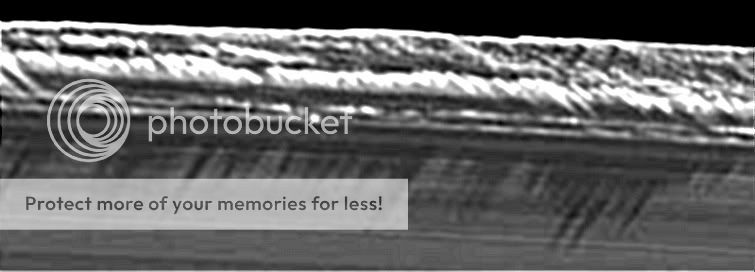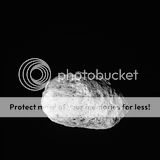M
Cassini Equinox & Solstice Mission, (nine year extension)!!.
Page 14 - Seeking answers about space? Join the Space community: the premier source of space exploration, innovation, and astronomy news, chronicling (and celebrating) humanity's ongoing expansion across the final frontier.
You are using an out of date browser. It may not display this or other websites correctly.
You should upgrade or use an alternative browser.
You should upgrade or use an alternative browser.
- Status
- Not open for further replies.
3
3488
Guest
Yes indeed, I agree Wayne.
A sharpened, enlarged crop I did.

Also an almost half lit Titan with equartorial clouds. Friday 29th October 2010.

Andrew Brown.
A sharpened, enlarged crop I did.

Also an almost half lit Titan with equartorial clouds. Friday 29th October 2010.

Andrew Brown.
B
brandbll
Guest
MeteorWayne":10os7dcb said:What an amazing image!!! I toast to you Cassini! :shock:
Yes, that picture is absolutely incredible!
E
EarthlingX
Guest
http://www.ciclops.org : Captain's Log, November 1, 2010
http://www.ciclops.org : Galactic Behavior for the Outer B Ring
http://www.ciclops.org : Strange Things Afoot in the B Ring
http://www.ciclops.org : Long Spiky Shadows
...More than a year has passed since the last entry in this log, a time spent in serious contemplation of the many remarkable discoveries we have made in the images we have collected on this historic journey.
And today marks the announcement and publication of one of the most remarkable. After a journey of nearly 100 circuits of Saturn covering 830 million kilometers, we have finally solved a set of puzzles that goes back to the days of Voyager.

http://www.ciclops.org : Galactic Behavior for the Outer B Ring
...Keeping a close watch on the outer portion of Saturn's B ring, NASA's Cassini spacecraft records the complex inward and outward movement of the edge of the ring. This ring movement resembles the suspected behavior of spiral disk galaxies.
...
http://www.ciclops.org : Strange Things Afoot in the B Ring
...The outer edge of Saturn's B ring exhibits an unexpected feature in this movie made from images captured by NASA's Cassini spacecraft. The images were obtained early in the planet's equinox "season" -- the period leading up to and away from August 11, 2009 when the sun was over the planet's equator and lit the rings exactly edge on.
...
http://www.ciclops.org : Long Spiky Shadows
...Vertical structures in the variable outer edge of Saturn's B ring cast shadows in these two images captured by NASA's Cassini spacecraft shortly after the planet's August 2009 northern vernal equinox.
E
EarthlingX
Guest
saturn.jpl.nasa.gov : Status Report: Engineers Assessing Cassini Spacecraft
Nov. 04, 2010
Engineers at NASA's Jet Propulsion Laboratory, Pasadena, Calif., are working to understand what caused NASA's Cassini spacecraft to put itself into "safe mode," a precautionary standby mode. Cassini entered safe mode around 4 p.m. PDT (7 p.m. EDT) on Tuesday, Nov. 2.
Since going into safe mode, the spacecraft has performed as expected, suspending the flow of science data and sending back only data about engineering and spacecraft health. Cassini is programmed to put itself into safe mode automatically any time it detects a condition on the spacecraft that requires action from mission controllers on the ground.
Engineers say it is not likely that Cassini will be able to resume full operations before a planned Nov. 11 flyby of Saturn's moon Titan. But Cassini has 53 more Titan flybys planned in its extended mission, which lasts until 2017.
"The spacecraft responded exactly as it should have, and I fully expect that we will get Cassini back up and running with no problems," said Bob Mitchell, Cassini program manager based at JPL. "Over the more than six years we have been at Saturn, this is only the second safing event. So considering the complexity of demands we have made on Cassini, the spacecraft has performed exceptionally well for us."
Since Cassini launched in 1997, Cassini has put itself into safe mode a total of six times.
The Cassini-Huygens mission is a cooperative project of NASA, the European Space Agency and the Italian Space Agency. The Jet Propulsion Laboratory, a division of the California Institute of Technology in Pasadena, manages the mission for NASA's Science Mission Directorate, Washington.
Jia-Rui C. Cook 818-354-0850
Jet Propulsion Laboratory, Pasadena, Calif.
jia-rui.c.cook@jpl.nasa.gov 2010-374
E
EarthlingX
Guest
www.jpl.nasa.gov : Status Update: Cassini to Resume Nominal Operations
...November 09, 2010
Engineers at NASA's Jet Propulsion Laboratory, Pasadena, Calif., expect the Cassini spacecraft will resume normal operations on Nov. 24. They have traced the steps taken by an onboard computer before Cassini put itself in precautionary "safe mode" last week.
Mission managers determined that the spacecraft went into safe mode because of a flip of a bit in the command and data system computer. The bit flip prevented the computer from registering an important instruction, and the spacecraft, as programmed, went into the standby mode. Engineers are still working to understand why the bit flipped.
Since the spacecraft went into safe mode on Nov. 2, the onboard computer with the bit flip has been reset and one of the science instruments has been turned back on to keep it warm. Over the next week or so, engineers will bring the rest of the science instruments back online.
Playback from the computer's memory is enabling engineers to extract science data collected before the spacecraft entered safe mode. The flow of science data is expected to resume when the instruments are powered back on next week.
"The bit flip happened in exactly the wrong location -- almost any place else would have merely resulted in a rejected command -- but the spacecraft responded exactly as programmed," said Bob Mitchell, Cassini program manager at JPL. "Cassini is in excellent shape, and we are looking forward to the next seven years of this mission."
E
EarthlingX
Guest
http://www.nasa.gov : Cassini's CIRS Reveals Saturn Is on a Cosmic Dimmer Switch
...11.10.10
Like a cosmic light bulb on a dimmer switch, Saturn emitted gradually less energy each year from 2005 to 2009, according to observations by NASA’s Cassini spacecraft. But unlike an ordinary bulb, Saturn's southern hemisphere consistently emitted more energy than its northern one. On top of that, energy levels changed with the seasons and differed from the last time a spacecraft visited in the early 1980s. These never-before-seen trends came from an analysis of comprehensive data from the Composite Infrared Spectrometer (CIRS), an instrument built by NASA's Goddard Space Flight Center in Greenbelt, Md., as well as a comparison with earlier data from NASA's Voyager spacecraft. When combined with information about the energy coming to Saturn from the sun, the results could help scientists understand the nature of Saturn's internal heat source.
The findings were reported November 9 in the Journal of Geophysical Research-Planets by Liming Li of Cornell University in Ithaca, N.Y. (now at the University of Houston), and colleagues from several institutions, including Goddard and NASA's Jet Propulsion Laboratory in Pasadena Calif., which manages the Cassini mission. "The Cassini CIRS data are very valuable because they give us a nearly complete picture of Saturn," says Li. "This is the only single data set that provides so much information about this planet, and it's the first time that anybody has been able to study the power emitted by one of the giant planets in such detail."
The planets in our solar system lose energy in the form of heat radiation in wavelengths that are invisible to the human eye. The CIRS instrument picks up wavelengths in the thermal infrared region, which is beyond red light, where the wavelengths correspond to heat emission.
"In planetary science, we tend to think of planets as losing power evenly in all directions and at a steady rate," says Li. "Now we know Saturn is not doing that." (Power is the amount of energy emitted per unit of time.)
...
From one Saturn year to the next, dramatic changes are seen in the emitted power and effective temperature on Saturn. Power is the amount of energy emitted per unit of time. The blue line shows data taken by NASA’s Voyager 1 and Voyager 2 spacecraft in November 1980 and August 1981. The red line shows data taken by the Composite Infrared Spectrometer aboard NASA’s Cassini spacecraft in May 2009, which is one year later on Saturn. In 2009, the southern hemisphere of Saturn is emitting more power and its effective temperature is noticeably warmer compared to the northern hemisphere. Nothing like this is seen in the data from 1980 to 1981. Credit: Adapted from the Journal of Geophysical Research, Vol. 115, E11002, 2010, doi:10.1029/2010JE003631.
3
3488
Guest
Great news thatr Cassini is back to full operation.
Also interesting news from the March Rhea encounter.
Tenuous Oxygen & CO2 atmosphere detected at Rhea.
Andrew Brown.
Also interesting news from the March Rhea encounter.
Tenuous Oxygen & CO2 atmosphere detected at Rhea.
Andrew Brown.
3
3488
Guest
One of the first observations from the recovered Cassini Spacecraft after safing.
On Saunday 28th November 2010, Cassini passed by Hyperion at approx 72,000 KM at closest approach.
Hyperion is 360 KM x 280 KM x 225 KM in size & from a a close pass early in the mission, in September 2005, the density is only 0.55 GM/3, the least dense known of the 'solid' bodies in our entire solar system. Hyperion is certainly made of ice like a giant comet nucleus.
Unlike most of the main moons of Saturn, Hyperion does not keep the same face turned towards Saturn. Hyperion orbits Saturn once every 21 days at a distance from Saturn of 1,481,100 KM, or nearly four times further than our own moon orbits Earth. Hyperion rotates on its axis once every 13 days. So every one orbit around Saturn, Hyperion rotates roughly 1.5 times.
Clickable thumbnails to the: Sunday 28th November 2010 images of Hyperion.






[youtube]http://www.youtube.com/watch?v=il1igwWjPds[/youtube]
Andrew Brown.
On Saunday 28th November 2010, Cassini passed by Hyperion at approx 72,000 KM at closest approach.
Hyperion is 360 KM x 280 KM x 225 KM in size & from a a close pass early in the mission, in September 2005, the density is only 0.55 GM/3, the least dense known of the 'solid' bodies in our entire solar system. Hyperion is certainly made of ice like a giant comet nucleus.
Unlike most of the main moons of Saturn, Hyperion does not keep the same face turned towards Saturn. Hyperion orbits Saturn once every 21 days at a distance from Saturn of 1,481,100 KM, or nearly four times further than our own moon orbits Earth. Hyperion rotates on its axis once every 13 days. So every one orbit around Saturn, Hyperion rotates roughly 1.5 times.
Clickable thumbnails to the: Sunday 28th November 2010 images of Hyperion.






[youtube]http://www.youtube.com/watch?v=il1igwWjPds[/youtube]
Andrew Brown.
- Status
- Not open for further replies.
Similar threads
- Replies
- 0
- Views
- 7K
3
- Replies
- 87
- Views
- 16K
T
3
- Replies
- 12
- Views
- 2K
M
TRENDING THREADS
-
New interpretation of QM, with new two-phase cosmology, solves 15 foundational problems in one go.
- Started by Geoff Dann
- Replies: 320
-
Hubble Tension explained (including its value) by the two phase cosmology
- Started by Geoff Dann
- Replies: 210
-
Basic Error: The accelerating Universe conclusion - reason
- Started by Gibsense
- Replies: 263
-
-
The birth of the Quantum Convergence Threshold (QCT):
- Started by Capanda Research
- Replies: 84
-
-

Space.com is part of Future plc, an international media group and leading digital publisher. Visit our corporate site.
© Future Publishing Limited Quay House, The Ambury, Bath BA1 1UA. All rights reserved. England and Wales company registration number 2008885.






